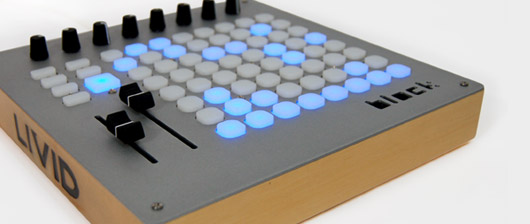Livid Instruments Block review

Many major companies seem to be jumping on the bandwagon to manufacture controllers for Ableton Live and other music software at the moment, so is Livid Instruments Block a pointless foray into a saturated market or a worthy effort? Juno Plus scribe Ben Daly finds out.
Livid Instruments are widely known for their bespoke hand crafted control surfaces and they continue this tradition with the release of their latest incarnation, the Block. Handmade in the US, the Block is a boutique product crafted from fine woods and quality metals, and completely designed, manufactured, and assembled at the Livid Instruments HQ in Austin, Texas.
The Block comes housed in a tastefully varnished wooden casing with all the electronics within. The words ‘Livid’ and their logo are branded on the Block and add a nice hand-finished feel. Topped with a sleek, brushed aluminium faceplate, the Block oozes quality and attention to detail. It’s a well made product with a sturdy casing and robust buttons, faders and rotaries. The faders and rotaries feel firm without being stiff and the blue backlit buttons have a rubberized texture for grip. The buttons feel slightly sticky but I’m sure these will wear-in through use. All the components used in the block feel far from flimsy and I’m sure that Livid have gone out of their way to source high quality parts.
“The Block will have a wide appeal due to its reprogrammable nature and should surely find itself in the hands of DJs, producers, VJs or anyone who uses software that supports MIDI”
Looking at the layout, the Block is simple and uncluttered, with a grid of 64 buttons (8×8) taking centre stage, a row of eight knobs along the top, two faders on the bottom left-hand side and seven function buttons above the faders.
The Block is perfectly sized and will fit into a laptop bag or backpack easily for transporting to and from gigs. With just a single USB socket on the back providing the power and communication with the computer, setup is simple and straightforward. It is plug-and-play so no drivers are required, but an editor for the Block is available from the Livid Instruments website should you wish to re-map the controller to your taste. The blue backlit buttons of the Block provide a quick and easy visual reference for users and will be invaluable in darkened environments.
In use, the Block is easy to get to grips with and its sturdiness reassuring. It’s very fun and quick to assign the parameters to Live using Ableton’s MIDI learn feature, leaving you free to get creative rather than feel bogged down with tech jargon and a hefty manual. In fact, the Block doesn’t come with any manual at all which some could see as a downside, others a refreshing change. Ultimately, less time spent trawling through a manual means more hands-on time with the Block, so surely it’s a good thing?
“In use, the Block is easy to get to grips with and its sturdiness reassuring. It’s very fun and quick to assign the parameters to Live using Ableton’s MIDI learn feature, leaving you free to get creative rather than feel bogged down with tech jargon and a hefty manual”
The Block will have a wide appeal due to its reprogrammable nature and should surely find itself in the hands of DJs, producers, VJs or anyone who uses software that supports MIDI.
One gripe would be the fact that the Block didn’t stay perfectly level on the table and rocked slightly while in use. Unfortunately the nature of wood means that it isn’t always going to be perfect, unlike injection-moulded plastic or metal casing. A bit of Blu-Tack underneath one of the feet or a folded piece of card will solve the problem, but after spending £349 on a controller it’s not what most people expect to have to do.
Minor grievances aside, the Block certainly has an edge over most competitors – its ease of use, ruggedness and tasteful design certainly deserve consideration.
Review: Ben Daly
